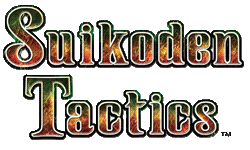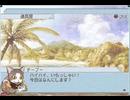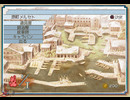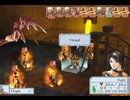|
|

|
BATTLE SYSTEM
|

|
INTERACTION
|

|
ORIGINALITY
|

|
STORY
|

|
MUSIC & SOUND
|

|
VISUALS
|

|
CHALLENGE
|
Easy
|
COMPLETION TIME
|
25-75+ Hours
|
|
OVERALL
3.5/5
|
Rating definitions
|
|
|
The Suikoden series, lately, has come under fire by reason of growing gamer and critic dissatisfaction with the franchise's offerings. Thus, the announcement that Konami was producing a tactical RPG spinoff of the series naturally stirred much trepidation from the RPG community, especially given that Konami was basing it off of the franchise's least venerated installment, Suikoden IV. The spinoff, Rhapsodia, which would come to America as Suikoden Tactics, however, actually proves to be an enjoyable title, despite its flaws.
Upon starting a new game, players can import data from Suikoden IV. Clear data that the player hasn't used to start a New Game+ for that game will work, and allows for the acquisition of secret characters late into Suikoden Tactics.
Battles are central to any tactical RPG, and luckily, Suikoden Tactics largely excels in this area. After the player selects a party, battles begin, with all characters and enemies taking their turns from fastest to slowest, and a speed gauge at the top of the screen showing who goes when. Central to the battle system are the game's five elements, fire, wind, earth, lightning, and water, with each character and enemy associated with one of these elements. Both sides, through use of items, runes, or free-moving orbs that randomly tread the battlefield, can create panels with one of the five elements, and depending on a character or foe's element, stepping onto one of these affected squares yields a certain effect.
 Bonus points for cat-people
Bonus points for cat-people
|
|
For instance, if a character's element is fire, stepping onto a fire panel will give him or her stat increases and gradual HP recovery after his or her turn ends. If a character associated with wind were to step on a fire panel, however, he or she would receive stat decreases and have his or her HP taken away at the end of his or her turns. Characters of any other element, on the other hand, will receive no benefit or penalty either way from a fire panel. This system adds strategy to battles, and is, in many instances, the difference between victory and defeat.
Another interesting part of the battle system is the bubbles that pop up above enemies when the player is deciding where to move a character, which indicate various things, such as if a character can kill an enemy with a normal attack, if the enemy can counterattack, if the enemy can move and attack that character, if a character will receive a stat gain or penalty by stepping on an elemental panel, and so forth. This system saves the time and annoyance of constantly checking enemy stats and the terrain to find out where to safely move a character, and should be present in other tactical RPGs.
One main flaw with the battle system, though, is that many characters, chiefly those that don't play part in the game's story, can die permanently (story characters simply "withdraw" when their HP reaches zero). Those that fear such losses, though, can instantly restart battles, although the game will reset all experience characters acquired before restarting the fight. However, if all characters used in battle withdraw or die, the player can restart the fight will all experience acquired kept intact, characters that died revived, and items used reset. Another issue is that many battles have a nasty habit of plunking in additional enemies after players have killed a certain number of foes or advanced to a certain part of a map.
 Menus--a necessary evil
Menus--a necessary evil
|
|
Players, furthermore, eventually gain the ability to switch a character active in battle with another they aren't using, although the character they switch out can't return to the battle. This comes in handy, for instance, when the player wishes the exploit certain elemental terrain, characters the player is using are low on health, and so forth. Certain characters, moreover, can gain cooperative attacks after using the "Talk" command that becomes available once in a while enough times; talking also increases "Good Will" between particular characters. Additionally, anytime in battle, players can save and quit their game, and continue the fight where they left off at a later time.
As with most other tactical RPGs, characters gain experience by performing any action, with a thousand experience points necessary to level up, in which instance not only stats increase, but all health recovers as well, sparing some dependence on healing items. Each character can bring eight items into battle, with accessories consuming their inventories. After a battle ends, the player gains money, skill points, and a special item depending upon how well his or her characters performed in the fight.
The skill system from Suikoden III returns in Suikoden Tactics, with all skill points pooled this time around, free for distribution among all characters. Skills are sundry and include Battle Lust, where a character can swing his or her weapon multiple times with one physical attack, and Counterattack, which speaks for itself. Each character can equip runes, as well, with characters having four levels of MP and one skill for each level per rune.
Suikoden Tactics also features a number of Guild Quests players can perform for extra money and skill points, involving various tasks such as finding certain items, fighting extra battles, and sending individual characters on dispatch missions for a few days. After completing a certain number of Quests, the player's guild rank increases, allowing for more advanced Guild Quests.
As long as players take advantage of elemental terrain, they'll have a largely easy time with Suikoden Tactics, especially considering the game is much nicer to them than most other tactical RPGs if they lose battles. Ultimately, the battle system is mostly enjoyable.
Interaction could've been better, though. Navigating the menus and advancing the game are hardly problems, though there are a few annoyances that add a lot of time to character management, such as the inability to move between character inventories with the L and R buttons and the inability to manage character equipment while shopping, which can prove cumbersome given your potential party size. The translation could've certainly been better, as well, and overall, interaction leaves plenty of room for improvement.
 "Hmm, maybe tossing that Meteo spell at my own party was a huge mistake..."
"Hmm, maybe tossing that Meteo spell at my own party was a huge mistake..."
|
|
The system of bubbles in battle is what mainly separates Suikoden Tactics from other tactical RPGs, although it borrows many elements from the main Suikoden games, such as runes, combo attacks, and much of the cast from Suikoden IV. Moreover, the elemental panel system is similar to, though not exactly like, the Geo Panels from Disgaea, and the Guild Quests resemble the mission systems from the Final Fantasy Tactics games. In the end, Suikoden Tactics is somewhere in the middle in terms of creativity.
The story takes place both before and after the events of Suikoden IV. A man named Walter is investigating Rune Cannons with a few associates and his son Kyril. Years later, Kyril continues his father's work, traveling through the Kooluk Empire with his companions in their investigation. The plot expands nicely on the story of Suikoden IV, adding depth to the Kooluk Empire and Rune Cannons, although character development is somewhat scant. There are a few interesting twists, though, and ultimately, the story glues the game together decently.
The music in Suikoden Tactics is pretty good, with much consisting of remixed tunes from Suikoden IV, and including folk music, orchestrated battle themes, and the occasional beautiful cutscene piece. The only problem I had with the music is that entering shops in towns constantly triggers new tunes. The voice acting is fairly spotty, as well, yet the sound, alongside the battles, is one of the game's high points.
The graphics could've used a bit of improvement, though. Character models are cel-shaded, yet end up looking a bit like Lego men, with their facial features being a bit hard to discern. The environments look fairly rushed, too, with their textures appearing dull close-up, although the character designs (except for many NPCs that are at times literally faceless) and still art are nice. In the end, Suikoden Tactics doesn't have the best visuals on the Playstation 2 yet doesn't have the worst, either.
Finally, depending upon whether or not the player decides to spend time with the Guild Quests, Suikoden Tactics can take anywhere from twenty-five to seventy-five hours to complete, with a New Game+ thrown into the mix, as well. Ultimately, Suikoden Tactics proves to be one of the much more enjoyable tactical RPGs to come out in recent years, with solid battles and music shining above all else. It might not be as deep or complex as Disgaea or Final Fantasy Tactics, yet still proves to be a fun excursion through the ever-expanding Suikoden universe, and a nice companion to Suikoden IV, to boot.
Review Archives
|









